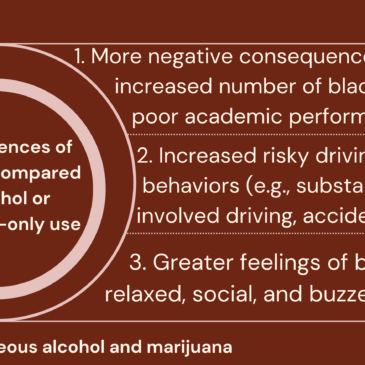Alcohol and marijuana are two of the most commonly used substances by young adults in the United States. People who use both substances tend to use each more frequently, are more likely to become dependent, and experience more negative consequences compared to those who only use one substance. It is, however, unclear how simultaneously using alcohol and marijuana impacts users. This week, STASH reviews a study by Christine Lee and colleagues that examined trends in published research articles related to simultaneous alcohol and marijuana (SAM) use in young adults.
What were the research questions?
How frequently are alcohol and marijuana used simultaneously? What are individuals’ motives, perceived norms, and perceived consequences of simultaneous alcohol and marijuana use?
What did the researchers do?
The authors conducted a scoping review of published studies on SAM use by young adults. Initially, the researchers identified 1,282 articles. After screening the articles for relevancy, the authors included a final sample of 74 research articles.
What did they find?
The review found that between 20% to 25% of young adults engaged in SAM use in the past year, with 6% to 7% of young adults frequently engaging in SAM use. Both young adult men and young adults who were white were more likely to engage in SAM use compared to young adult women and young adults of other ethnicities, respectively. Individuals who used alcohol or marijuana more heavily were also more likely to state SAM use. Young adults stated a variety of reasons for engaging in SAM use, including the desire to enhance the effects of both substances, to improve their ability to socialize with others, and to help cope with difficult situations. Most of the studies included in their sample reported on the negative consequences of SAM use, including blackouts, delinquent behavior, poor academic performance, decreased sleep quality, and increased risky driving behaviors. Four studies in their sample reported on the perceived positive effects of SAM use, which included greater feelings of relaxation, socialization, and being buzzed.
 Figure. This Figure depicts common consequences, reported in published research articles, associated with SAM use among young adults. Adapted from Lee and colleagues. Click image to enlarge.
Figure. This Figure depicts common consequences, reported in published research articles, associated with SAM use among young adults. Adapted from Lee and colleagues. Click image to enlarge.
Why do these findings matter?
Given how frequently young adults engage in SAM use and that SAM use is associated with worse negative consequences than alcohol or marijuana-only use, interventions addressing SAM use are warranted, especially for heavy alcohol or marijuana users. While there are effective approaches to individually decrease alcohol use (e.g., personalized feedback interventions) and marijuana use (e.g., family-based interventions) among young adults, research has not examined whether these interventions can influence other substance use behaviors aside from those they were originally designed to address. Future researchers and program developers may wish to take young adults’ motives for SAM use (e.g., enhancement, socialization, coping) into account when planning potential interventions.
Every study has limitations. What are the limitations in this study?
The review only included articles that had been published in a peer-reviewed journal and were available in English, which means that the review could have excluded potentially relevant articles. The review was also narrowly focused on SAM use among young adults, meaning that the results of the study cannot generalize to other populations.
For more information:
The National Institute on Alcohol Abuse and Alcoholism has tips and resources for people struggling with problem drinking. If you are worried that you or someone you know is experiencing addiction, the SAMHSA National Helpline is a free treatment and information service available 24/7. For more details about addiction, visit our Addiction Resources page.
–Seth McCullock, PhD
What do you think? Please use the comment link below to provide feedback on this article.




